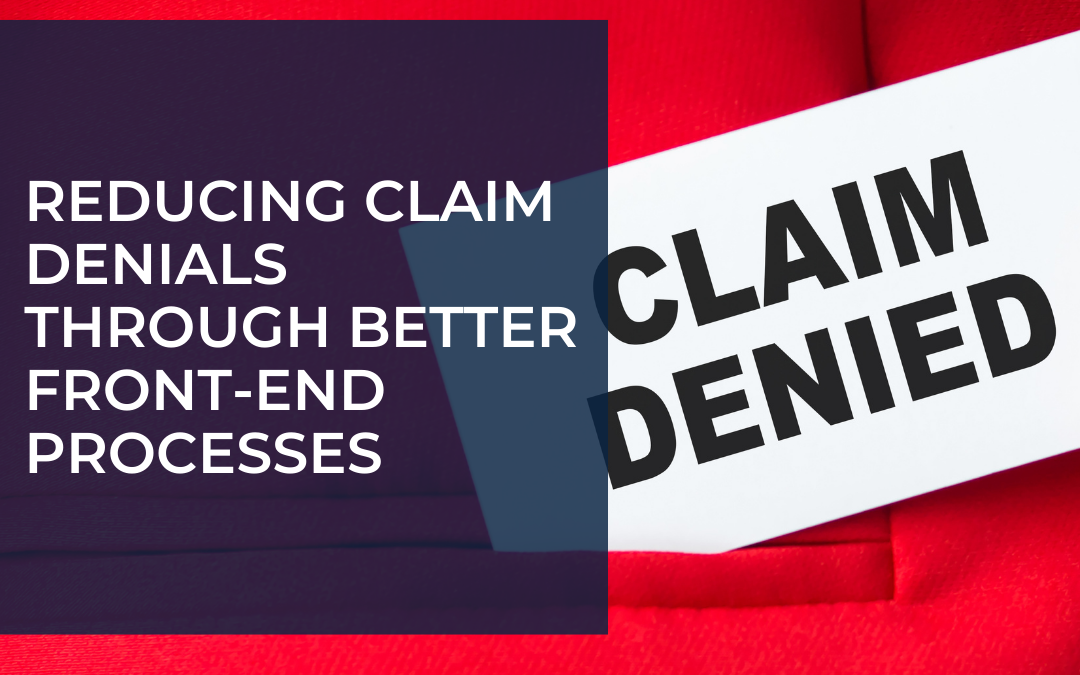Picture this: You’re a healthcare administrator reviewing last month’s financials, and the numbers make your stomach drop. Your practice processed 5,000 claims, but nearly 800 came back denied. That’s $240,000 in revenue sitting in limbo, requiring hours of staff time to rework, resubmit, and chase down payments. Sound familiar?
If you’re nodding your head, you’re not alone. Claim denials in healthcare cost the industry an estimated $262 billion annually in administrative waste. But here’s what might surprise you: most of these denials are entirely preventable. The secret isn’t hiring more appeals specialists or investing in better back-end recovery systems. It’s about getting things right the first time through stronger front-end processes.
Think about it – wouldn’t you rather prevent a house fire than become an expert at putting one out? The same logic applies to medical claim denials. When we focus on denial prevention strategies at the point of service, we’re essentially fireproofing our revenue cycle. This article will walk you through exactly how to do that, covering what claim denials really cost your practice, why front-end processes are your best defense, and five proven strategies to reduce denials before they happen.
What Are Claim Denials in Healthcare?
Let’s start with the basics – what exactly are claim denials in healthcare? Simply put, a denied claim is one that an insurance company has processed and determined they won’t pay for, either partially or in full. But not all denials are created equal.
Administrative denials happen when there’s a technical issue with how the claim was submitted. Maybe the patient’s name is spelled differently on their insurance card versus your registration form. Perhaps their insurance information is outdated, or a required prior authorization wasn’t obtained. These denials frustrate both patients and providers because the medical service was appropriate – the paperwork just wasn’t perfect.
Clinical denials, on the other hand, occur when the insurance company questions the medical necessity of the service provided. They might deny coverage for a procedure they deem experimental, or they might require additional documentation to prove the treatment was warranted. While clinical denials can be more complex to resolve, they’re still often preventable with better upfront planning.
Here’s where the math gets painful: research shows that reworking a denied claim costs three to five times more than submitting a clean claim initially. If processing a clean claim costs your practice $3, handling a denial can cost $9 to $15 when you factor in staff time for research, appeals preparation, phone calls to payers, and potential write-offs. Multiply that across hundreds of denials per month, and you’re looking at thousands of dollars in unnecessary expenses.
But the real tragedy? Industry data suggests that approximately 65% of denied claims are never reworked or resubmitted. They simply become write-offs, representing pure revenue loss that flows straight to the bottom line. When you consider that many practices operate on razor-thin margins, these preventable losses can mean the difference between growth and struggle.
Why Front-End Processes Are the Key to Denial Prevention
Here’s a question that might challenge conventional thinking: Why do most healthcare practices spend more time and energy on claim appeals than on preventing denials in the first place? It’s like mopping up water instead of fixing the leaky pipe causing the flood.
The traditional approach to healthcare revenue cycle management focuses heavily on the back-end – hiring denial management specialists, investing in appeals software, and training staff to become experts at overturning payer decisions. While these capabilities certainly have their place, they represent a fundamentally reactive strategy. You’re essentially planning to fail and then hoping to recover.
Front-end processes, however, offer a proactive approach. When we verify patient eligibility in real-time, ensure accurate registration data, obtain necessary authorizations, and submit clean claims from the start, we eliminate the vast majority of denial triggers before they ever become problems. It’s the difference between building a strong foundation and constantly patching cracks in the walls.
Consider two hypothetical practices of similar size. Practice A follows traditional patterns – minimal upfront verification, basic registration processes, and a dedicated denial management team to handle the inevitable rejections. Practice B invests in comprehensive front-end processes, with real-time eligibility verification, detailed registration protocols, and automated claim scrubbing before submission.
The numbers tell a compelling story. Practice A typically sees denial rates around 15-20%, with significant staff resources dedicated to reworking rejected claims. Their cash flow suffers from delayed payments, and staff morale takes a hit from constantly dealing with frustrated patients whose claims were denied. Practice B, meanwhile, maintains denial rates below 5%, enjoys faster payment cycles, and redirects their staff energy toward patient care and practice growth rather than administrative cleanup.
The choice seems obvious, yet many practices remain stuck in reactive patterns. Why? Often it’s because front-end improvements require upfront investment and process changes, while back-end fixes feel more immediate and tangible. But as any successful practice manager will tell you, an ounce of prevention truly is worth a pound of cure.
5 Ways to Reduce Claim Denials With Better Front-End Processes
1. Patient Eligibility Verification and Insurance Checks
Let’s talk about one of the biggest sources of preventable denials: eligibility issues. Have you ever had a patient come in for routine care, only to discover weeks later that their insurance wasn’t active or didn’t cover the service? It’s a scenario that plays out thousands of times daily across healthcare practices nationwide.
Eligibility-related denials are particularly frustrating because they’re almost entirely preventable with proper verification processes. When patients schedule appointments, their insurance information might be current. But by the time they arrive for their visit, circumstances may have changed – they might have switched jobs, their spouse’s employment status could have shifted, or their insurance company might have modified their coverage parameters.
Modern eligibility verification tools have revolutionized this process. Real-time verification systems can check patient coverage status, copay amounts, deductible information, and benefit limitations within seconds. These automated systems integrate directly with practice management systems, making verification a seamless part of the scheduling and check-in process rather than a manual task that sometimes gets skipped during busy periods.
But technology alone isn’t enough. Successful practices implement verification protocols that go beyond basic coverage checks. They verify secondary insurance coverage, confirm copay and deductible amounts, and identify any special authorization requirements for scheduled services. Staff members are trained to collect copays and deductibles at the time of service, rather than billing patients after the fact and risking collection issues.
Consider implementing a verification checklist that includes primary and secondary insurance verification, confirmation of coverage for planned services, collection of any required copays or deductibles, and documentation of any authorization requirements. When this process becomes routine, eligibility-related denials become rare exceptions rather than regular occurrences.
2. Accurate and Complete Patient Registration
Patient registration might seem straightforward, but it’s actually one of the most critical front-end processes for preventing medical claim denials. Even minor errors in demographic information can trigger automatic denials from insurance companies whose systems expect exact matches with their records.
Common registration errors include simple typos in patient names, incorrect dates of birth, wrong policy numbers, missing or incorrect addresses, and failure to capture insurance card changes. While these might seem like minor details, insurance companies’ automated processing systems are unforgiving when it comes to data accuracy. A single digit error in a policy number or a misspelled middle name can result in an immediate denial.
The solution involves a combination of staff training, technology integration, and quality control processes. Front desk staff should be trained to carefully review insurance cards, verify information with patients, and understand the importance of accuracy in every field. Electronic health record (EHR) systems can be configured with validation rules that flag potential errors before they become problems – for example, alerting staff when a birth date seems unrealistic or when required fields are left blank.
Technology can also streamline this process through patient portals that allow individuals to update their information online before appointments, and registration kiosks that enable patients to verify and correct their demographic data during check-in. Some practices have found success with photo capture of insurance cards, which eliminates transcription errors and provides visual confirmation of coverage details.
3. Prior Authorizations and Medical Necessity Documentation
Prior authorization requirements have become increasingly complex in recent years, with insurance companies requiring advance approval for more services than ever before. Failing to obtain required authorizations is a leading cause of clinical denials, often resulting in significant revenue loss for procedures that have already been performed.
The challenge with prior authorizations lies not just in obtaining them, but in knowing when they’re required in the first place. Different insurance companies have different requirements, and these requirements change frequently. What makes it even more complicated is that authorization requirements can vary based on the specific plan a patient has, not just their insurance company.
Successful practices implement systematic approaches to authorization management. This starts with maintaining current authorization requirement databases for major payers and specific plan types. Many practice management systems now include authorization tracking modules that flag services likely to require prior approval based on the patient’s insurance and the scheduled procedure.
Automation has become increasingly important in this area. Some practices use software that automatically checks authorization requirements when appointments are scheduled, generates authorization requests electronically, and tracks approval status throughout the process. This proactive approach ensures that necessary authorizations are obtained well before service dates, preventing last-minute cancellations and subsequent denials.
Staff training is equally crucial for authorization success. Team members need to understand not just how to request authorizations, but how to document medical necessity effectively. Insurance companies are looking for specific clinical indicators that justify the requested services, and authorization requests that fail to provide this information are likely to be denied.
Consider implementing a pre-service review process for high-risk services. Before scheduling procedures that commonly require authorization, clinical staff can review patient charts to ensure medical necessity is well-documented and that all required supporting documentation is available. This upfront investment of time often prevents much larger problems down the road.
4. Coding Accuracy and Documentation Quality
Coding errors represent another significant source of preventable claim denials in healthcare. When diagnostic codes don’t match procedure codes, when codes are too general or too specific, or when required modifiers are missing, insurance companies often reject claims automatically.
The complexity of medical coding has increased dramatically with the implementation of ICD-10 and ongoing updates to procedural coding systems. What used to be straightforward coding decisions now require detailed clinical knowledge and understanding of payer-specific requirements. A service that’s coded correctly for one insurance company might be denied by another due to different coverage policies or coding preferences.
Front-end clinical documentation improvement (CDI) programs can significantly reduce coding-related denials. These programs focus on ensuring that providers document care in ways that support accurate coding from the start, rather than trying to interpret inadequate documentation after the fact. When clinical documentation clearly supports the services provided, coders can assign appropriate codes with confidence, reducing the likelihood of denials.
Education plays a vital role in coding accuracy. Providers need ongoing training on documentation requirements, and coding staff need regular updates on payer policy changes and coding guideline updates. Many successful practices hold monthly meetings where common coding issues are discussed, denial trends are reviewed, and best practices are shared among team members.
Integrated coding support within EHR systems can also help prevent errors. Modern systems can suggest appropriate codes based on documented diagnoses and procedures, flag potential coding conflicts, and provide decision support for complex coding scenarios. While these tools don’t replace the need for skilled coding professionals, they can help prevent many common errors that lead to denials.
Some practices have found success with pre-billing coding reviews, where experienced coders or certified coding specialists review claims before submission to identify potential issues. This quality control step can catch errors that might otherwise result in denials, allowing for corrections before claims enter the revenue cycle.
5. Clean Claim Submission and Data Validation
A “clean claim” is one that contains all necessary information, is coded correctly, and meets all payer requirements for processing without additional information requests. Achieving high clean claim rates requires attention to detail at every step of the revenue cycle process, from patient registration through final claim submission.
Claim scrubbing technology has become an essential tool for ensuring clean claim submission. These systems review claims against thousands of payer-specific rules before submission, identifying potential issues that could result in denials or rejections. Common issues caught by claim scrubbers include missing or invalid diagnosis codes, procedure codes that don’t match diagnoses, missing required modifiers, and demographic information that doesn’t match insurance company records.
But technology is only as effective as the processes supporting it. Staff accountability measures are crucial for maintaining high clean claim rates. This might include regular monitoring of individual staff member error rates, feedback sessions when patterns of errors are identified, and recognition programs for team members who consistently achieve high accuracy rates.
Data validation extends beyond basic claim scrubbing to include verification that all required supporting documentation is available and properly linked to claims. For services requiring prior authorization, clean claim submission means ensuring that authorization numbers are included and that the services billed match exactly what was authorized.
Payer-specific rules add another layer of complexity to clean claim submission. Different insurance companies have different requirements for claim formatting, required fields, and supporting documentation. Successful practices maintain current knowledge of these requirements and configure their systems to accommodate payer-specific needs.
Regular monitoring of rejection and denial patterns can provide valuable feedback on clean claim submission processes. When the same types of errors appear repeatedly, it usually indicates a need for process improvement, additional staff training, or system configuration changes.
How to Get Started With Front-End Denial Prevention
Transforming your practice’s approach to denial prevention doesn’t happen overnight, but you can start seeing results quickly with a systematic implementation approach. The key is to prioritize changes based on your practice’s specific denial patterns and available resources.
Start with a denial analysis to understand where your biggest opportunities lie. Review the last three to six months of denials, categorizing them by type (eligibility, registration, authorization, coding, or other issues). This analysis will show you which front-end processes need the most attention and help you prioritize improvement efforts where they’ll have the biggest impact.
Technology investments should align with your identified priorities. If eligibility issues are your biggest problem, real-time verification systems should be your first priority. If coding errors are driving most denials, coding support tools and CDI programs might offer the best return on investment. Don’t try to implement everything at once – focus on one or two key areas and do them well.
Staff training is critical for any front-end improvement initiative. Team members need to understand not just new processes, but why these changes matter for the practice’s financial health. Regular training sessions, clear procedure documentation, and ongoing feedback help ensure that new processes become permanent parts of your workflow rather than temporary improvements that fade over time.
Consider implementing measurement systems to track your progress. Key metrics might include clean claim rates, first-pass resolution rates, denial rates by category, and staff accuracy measures. Regular reporting on these metrics helps maintain focus on front-end processes and provides early warning when performance starts to slip.
Automation opportunities should be evaluated continuously. As technology improves and becomes more affordable, processes that once required manual intervention can often be automated. The goal isn’t to replace human judgment, but to free staff from routine tasks so they can focus on complex issues that require personal attention.
Conclusion: Don’t Let Denials Drain Your Revenue
We’ve covered a lot of ground in this discussion about reducing claim denials through better front-end processes, but the core message is simple: prevention beats recovery every time. When you invest in getting things right from the start – accurate registration, real-time eligibility verification, proper authorizations, clean coding, and systematic claim validation – you eliminate the vast majority of denial triggers before they become problems.
Ready to transform your practice’s approach to denial prevention and strengthen your revenue cycle? The experts at QMACS understand the challenges healthcare practices face in today’s complex reimbursement environment. Whether you need help implementing front-end process improvements, staff training, or comprehensive revenue cycle optimization, we’re here to support your success. Schedule a consultation today to discover how we can help you reduce denials, improve cash flow, and build a stronger financial foundation for your practice’s future.


